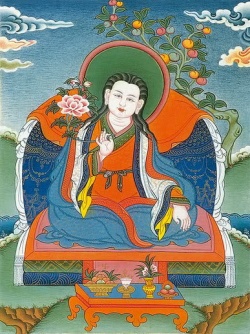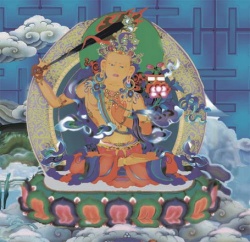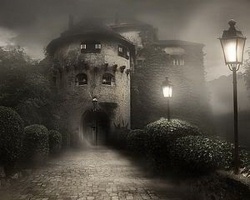Difference between revisions of "Sri Maha Heruka"
| Line 1: | Line 1: | ||
{{DisplayImages|1908|310|1413}} | {{DisplayImages|1908|310|1413}} | ||
<poem> | <poem> | ||
| − | Apart from the colours, the other clue that we are [[seeing]] transmuted [[forms]] of the [[peaceful]] [[Buddhas]] is their {{Wiki|emblems}}. In their four outer arms they brandish [[weapons]], or implements associated with [[death]]. However, their central pair of arms, with which they embrace their [[consorts]], hold {{Wiki|emblems}} that are not menacing. In every case, in their central left hand they hold a [[bell]], [[symbol]] of the [[Emptiness]] of which they are just another [[manifestation]]. In their central right hand each figure holds the emblem of his [[peaceful]] counterpart. So the Glorious [[Great Buddha]] [[Heruka]] holds the golden [[wheel]] of [[Vairocana]], and so on. (Rather than a [[double vajra]], the [[Karma Heruka]] holds a sword, which is another emblem associated with [[Amoghasiddhi]].) | + | Apart from the colours, the other clue that we are [[seeing]] transmuted [[forms]] of the [[peaceful]] [[Buddhas]] is their {{Wiki|emblems}}. In their four outer arms they brandish [[weapons]], or implements associated with [[death]]. However, their central pair of arms, with which they embrace their [[consorts]], hold {{Wiki|emblems}} that are not menacing. In every case, in their central left hand they hold a [[bell]], [[symbol]] of the [[Emptiness]] of which they are just another [[manifestation]]. In their central right hand each figure holds the {{Wiki|emblem}} of his [[peaceful]] counterpart. So the Glorious [[Great Buddha]] [[Heruka]] holds the golden [[wheel]] of [[Vairocana]], and so on. (Rather than a [[double vajra]], the [[Karma Heruka]] holds a sword, which is another {{Wiki|emblem}} associated with [[Amoghasiddhi]].) |
| − | Along with these [[wrathful deities]] comes a host of [[wrathful]] {{Wiki|female}} figures. They are of various colours, some animal-headed, most carrying [[symbols]] of [[death]]. In this way no less than fifty-eight figures appear, forming a [[mandala]] with the [[Great Buddha]] [[Heruka]] at its centre. In every case the text [[urges]] us to see their [[appearance]] as an opportunity to break through to [[wisdom]]. If we can see their true [[empty]] [[nature]], it says, we shall [[feel]] like someone who suddenly [[recognizes]] that a [[lion]] of which they have been terrified was only a stuffed one. 6 [[Tantra]] sees [[samsara and nirvana]] as {{Wiki|interrelated}} In what we might call 'basic [[Buddhism]]' [[samsara and nirvana]] are, for all practical purposes, a [[duality]]. You find yourself in the [[painful]] state of [[samsara]], and set out on the [[path]] to leave it behind by [[attaining]] the [[peace]] of [[nirvana]]. | + | Along with these [[wrathful deities]] comes a host of [[wrathful]] {{Wiki|female}} figures. They are of various colours, some animal-headed, most carrying [[symbols]] of [[death]]. In this way no less than fifty-eight figures appear, forming a [[mandala]] with the [[Great Buddha]] [[Heruka]] at its centre. In every case the text [[urges]] us to see their [[appearance]] as an opportunity to break through to [[wisdom]]. If we can see their true [[empty]] [[nature]], it says, we shall [[feel]] like someone who suddenly [[recognizes]] that a [[lion]] of which they have been terrified was only a stuffed one. 6 [[Tantra]] sees [[samsara and nirvana]] as {{Wiki|interrelated}} In what we might call 'basic [[Buddhism]]' [[samsara and nirvana]] are, for all {{Wiki|practical}} purposes, a [[duality]]. You find yourself in the [[painful]] [[state]] of [[samsara]], and set out on the [[path]] to leave it behind by [[attaining]] the [[peace]] of [[nirvana]]. |
| − | The [[Vajrayana]], however, correlates everything in [[samsara]] with an aspect of [[Enlightenment]]. The five [[Poisons]], for the [[Tantra]], are really expressions of the [[five Buddhas]]. In this way, [[samsara and nirvana]] cease to be a complete [[dualism]]. They are subsumed into a higher [[vision]] in which everything is an expression of [[Reality]]. The [[Vajrayana]] follows the [[principle]] of hermetic [[magic]], 'as above so below'. By manipulating the [[mundane]], it aims to effect changes on the [[spiritual]] level. By [[seeing]] the [[mundane]] as a {{Wiki|reflection}} of the [[Enlightened]], it imbues the [[world]] with a [[sacred]] quality. This has a [[transforming]] effect. If whenever you see the {{Wiki|colour}} green it reminds you of the [[Bodhisattva Tara]], who is often portrayed as green in {{Wiki|colour}}, or you [[recognize]] your [[desire]] for [[food]] as simply misplaced [[desire]] for [[Enlightenment]], then the [[world]] begins to change. | + | The [[Vajrayana]], however, correlates everything in [[samsara]] with an aspect of [[Enlightenment]]. The five [[Poisons]], for the [[Tantra]], are really {{Wiki|expressions}} of the [[five Buddhas]]. In this way, [[samsara and nirvana]] cease to be a complete [[dualism]]. They are subsumed into a higher [[vision]] in which everything is an expression of [[Reality]]. The [[Vajrayana]] follows the [[principle]] of hermetic [[magic]], 'as above so below'. By manipulating the [[mundane]], it aims to effect changes on the [[spiritual]] level. By [[seeing]] the [[mundane]] as a {{Wiki|reflection}} of the [[Enlightened]], it imbues the [[world]] with a [[sacred]] [[quality]]. This has a [[transforming]] effect. If whenever you see the {{Wiki|colour}} [[green]] it reminds you of the [[Bodhisattva Tara]], who is often portrayed as [[green]] in {{Wiki|colour}}, or you [[recognize]] your [[desire]] for [[food]] as simply misplaced [[desire]] for [[Enlightenment]], then the [[world]] begins to change. |
The correlations the [[Tantra]] makes between the [[mundane]] and the [[spiritual]] are vast and complex, and we will not have room to {{Wiki|touch}} on more than a small fraction of them. 7 [[Tantra]] begins at the [[highest]] point There is a [[Zen]] saying, 'If you want to climb a mountain, begin at the top.' The [[Vajrayana]] would laughingly agree with this. We've seen that [[Tantra]] is {{Wiki|pragmatic}}, it deals in direct [[experience]]. So if you have no direct [[experience]] of [[Buddhahood]], it asks you to [[imagine]], to 'act as though', to [[visualize]] yourself as a [[Buddha]] or [[Bodhisattva]]. In this way you gain a {{Wiki|taste}} for what it would be like to be filled with [[love]] and [[wisdom]]. | The correlations the [[Tantra]] makes between the [[mundane]] and the [[spiritual]] are vast and complex, and we will not have room to {{Wiki|touch}} on more than a small fraction of them. 7 [[Tantra]] begins at the [[highest]] point There is a [[Zen]] saying, 'If you want to climb a mountain, begin at the top.' The [[Vajrayana]] would laughingly agree with this. We've seen that [[Tantra]] is {{Wiki|pragmatic}}, it deals in direct [[experience]]. So if you have no direct [[experience]] of [[Buddhahood]], it asks you to [[imagine]], to 'act as though', to [[visualize]] yourself as a [[Buddha]] or [[Bodhisattva]]. In this way you gain a {{Wiki|taste}} for what it would be like to be filled with [[love]] and [[wisdom]]. | ||
| − | Not only that, [[imagination]] is not just fantasy. For [[Buddhism]] your [[mental state]] is decisive for the power of your [[actions]]. If you can project yourself completely into the [[experience]], into the jewelled sandals of a [[Bodhisattva]], even for a few seconds, then for that [[time]], to all intents and purposes, you are that [[Bodhisattva]]. The [[Tantra]] takes this to its [[logical]] conclusion in the [[anuttarayoga]]. It asks you to act all the [[time]] as though you were an [[Enlightened being]], and to try to see the [[world]] as a [[Buddha]] would see it. | + | Not only that, [[imagination]] is not just [[fantasy]]. For [[Buddhism]] your [[mental state]] is decisive for the power of your [[actions]]. If you can project yourself completely into the [[experience]], into the jewelled sandals of a [[Bodhisattva]], even for a few seconds, then for that [[time]], to all intents and purposes, you are that [[Bodhisattva]]. The [[Tantra]] takes this to its [[logical]] conclusion in the [[anuttarayoga]]. It asks you to act all the [[time]] as though you were an [[Enlightened being]], and to try to see the [[world]] as a [[Buddha]] would see it. |
| − | This is what our young woman in the shopping mall was doing. She was practising [[visualizing]] herself as a [[meditational deity]], identifying all [[sound]] as [[mantra]], and [[seeing]] her environment as a [[mandala]]. By taking up the [[state of mind]] of one who has completed the [[path]], you move along the [[path]] as fast as possible - this is the [[thinking]] of the [[Vajrayana]]. It has its dangers, which is why it needs a firm foundation in prior practice, but it also has tremendous advantages. If you are [[thinking]] of climbing a mountain, you can just sit on a stone at the bottom and day-dream about the [[view]] from the top. Or you can climb step by step, focusing your [[thoughts]] on the difficulties of the climb before you. Alternatively, you can climb while keeping in [[mind]] an imaginative [[vision]] of the magnificent vistas you will see from the summit; they can be so alluring that you will be led upwards, not noticing the difficulties of the climb. In a [[sense]], you are already at the top. | + | This is what our young woman in the shopping mall was doing. She was practising [[visualizing]] herself as a [[meditational deity]], identifying all [[sound]] as [[mantra]], and [[seeing]] her {{Wiki|environment}} as a [[mandala]]. By [[taking up]] the [[state of mind]] of one who has completed the [[path]], you move along the [[path]] as fast as possible - this is the [[thinking]] of the [[Vajrayana]]. It has its dangers, which is why it needs a firm foundation in prior practice, but it also has tremendous advantages. If you are [[thinking]] of climbing a mountain, you can just sit on a stone at the bottom and day-dream about the [[view]] from the top. Or you can climb step by step, focusing your [[thoughts]] on the difficulties of the climb before you. Alternatively, you can climb while keeping in [[mind]] an imaginative [[vision]] of the magnificent vistas you will see from the summit; they can be so alluring that you will be led upwards, not noticing the difficulties of the climb. In a [[sense]], you are already at the top. |
| − | Armed with these short explanations of some features of [[Tantra]], we can now encounter the [[Tantric deities]]. [[Prajnaparamita]], who acts as a kind of bridge. She is the only figure who also appears in the [[sutras]]. As we shall see, she {{Wiki|personifies}} a set of [[sutras]], transmuted into a [[goddess]] through the [[Tantric]] [[desire]] for direct [[experience]]. Then comes [[Vajrasattva]], the '[[diamond]] being', invoked for [[purification]] by followers of the '[[diamond way]]'. [[Buddha]], [[Dharma]], and [[Sangha]] are [[experienced]] through [[gurus]], [[yidams]], and [[dakinis]]. In the following chapter, if we are [[feeling]] strong, we can encounter the [[dharmapalas]], the [[Tantric]] [[protectors]] of the [[Dharma]]. | + | Armed with these short explanations of some features of [[Tantra]], we can now encounter the [[Tantric deities]]. [[Prajnaparamita]], who acts as a kind of bridge. She is the only figure who also appears in the [[sutras]]. As we shall see, she {{Wiki|personifies}} a set of [[sutras]], transmuted into a [[goddess]] through the [[Tantric]] [[desire]] for direct [[experience]]. Then comes [[Vajrasattva]], the '[[diamond]] being', invoked for [[purification]] by followers of the '[[diamond way]]'. [[Buddha]], [[Dharma]], and [[Sangha]] are [[experienced]] through [[gurus]], [[yidams]], and [[dakinis]]. In the following [[chapter]], if we are [[feeling]] strong, we can encounter the [[dharmapalas]], the [[Tantric]] [[protectors]] of the [[Dharma]]. |
</poem> | </poem> | ||
{{R}} | {{R}} | ||
[http://www.scribd.com/doc/147102817/The-Quintessence-of-Secret-Esoteric-Buddhism-Revised-Edition-2008 www.scribd.com] | [http://www.scribd.com/doc/147102817/The-Quintessence-of-Secret-Esoteric-Buddhism-Revised-Edition-2008 www.scribd.com] | ||
[[Category:Heruka]] | [[Category:Heruka]] | ||
Latest revision as of 22:43, 14 August 2022
Apart from the colours, the other clue that we are seeing transmuted forms of the peaceful Buddhas is their emblems. In their four outer arms they brandish weapons, or implements associated with death. However, their central pair of arms, with which they embrace their consorts, hold emblems that are not menacing. In every case, in their central left hand they hold a bell, symbol of the Emptiness of which they are just another manifestation. In their central right hand each figure holds the emblem of his peaceful counterpart. So the Glorious Great Buddha Heruka holds the golden wheel of Vairocana, and so on. (Rather than a double vajra, the Karma Heruka holds a sword, which is another emblem associated with Amoghasiddhi.)
Along with these wrathful deities comes a host of wrathful female figures. They are of various colours, some animal-headed, most carrying symbols of death. In this way no less than fifty-eight figures appear, forming a mandala with the Great Buddha Heruka at its centre. In every case the text urges us to see their appearance as an opportunity to break through to wisdom. If we can see their true empty nature, it says, we shall feel like someone who suddenly recognizes that a lion of which they have been terrified was only a stuffed one. 6 Tantra sees samsara and nirvana as interrelated In what we might call 'basic Buddhism' samsara and nirvana are, for all practical purposes, a duality. You find yourself in the painful state of samsara, and set out on the path to leave it behind by attaining the peace of nirvana.
The Vajrayana, however, correlates everything in samsara with an aspect of Enlightenment. The five Poisons, for the Tantra, are really expressions of the five Buddhas. In this way, samsara and nirvana cease to be a complete dualism. They are subsumed into a higher vision in which everything is an expression of Reality. The Vajrayana follows the principle of hermetic magic, 'as above so below'. By manipulating the mundane, it aims to effect changes on the spiritual level. By seeing the mundane as a reflection of the Enlightened, it imbues the world with a sacred quality. This has a transforming effect. If whenever you see the colour green it reminds you of the Bodhisattva Tara, who is often portrayed as green in colour, or you recognize your desire for food as simply misplaced desire for Enlightenment, then the world begins to change.
The correlations the Tantra makes between the mundane and the spiritual are vast and complex, and we will not have room to touch on more than a small fraction of them. 7 Tantra begins at the highest point There is a Zen saying, 'If you want to climb a mountain, begin at the top.' The Vajrayana would laughingly agree with this. We've seen that Tantra is pragmatic, it deals in direct experience. So if you have no direct experience of Buddhahood, it asks you to imagine, to 'act as though', to visualize yourself as a Buddha or Bodhisattva. In this way you gain a taste for what it would be like to be filled with love and wisdom.
Not only that, imagination is not just fantasy. For Buddhism your mental state is decisive for the power of your actions. If you can project yourself completely into the experience, into the jewelled sandals of a Bodhisattva, even for a few seconds, then for that time, to all intents and purposes, you are that Bodhisattva. The Tantra takes this to its logical conclusion in the anuttarayoga. It asks you to act all the time as though you were an Enlightened being, and to try to see the world as a Buddha would see it.
This is what our young woman in the shopping mall was doing. She was practising visualizing herself as a meditational deity, identifying all sound as mantra, and seeing her environment as a mandala. By taking up the state of mind of one who has completed the path, you move along the path as fast as possible - this is the thinking of the Vajrayana. It has its dangers, which is why it needs a firm foundation in prior practice, but it also has tremendous advantages. If you are thinking of climbing a mountain, you can just sit on a stone at the bottom and day-dream about the view from the top. Or you can climb step by step, focusing your thoughts on the difficulties of the climb before you. Alternatively, you can climb while keeping in mind an imaginative vision of the magnificent vistas you will see from the summit; they can be so alluring that you will be led upwards, not noticing the difficulties of the climb. In a sense, you are already at the top.
Armed with these short explanations of some features of Tantra, we can now encounter the Tantric deities. Prajnaparamita, who acts as a kind of bridge. She is the only figure who also appears in the sutras. As we shall see, she personifies a set of sutras, transmuted into a goddess through the Tantric desire for direct experience. Then comes Vajrasattva, the 'diamond being', invoked for purification by followers of the 'diamond way'. Buddha, Dharma, and Sangha are experienced through gurus, yidams, and dakinis. In the following chapter, if we are feeling strong, we can encounter the dharmapalas, the Tantric protectors of the Dharma.


